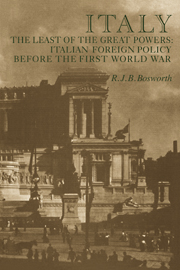Book contents
- Frontmatter
- Contents
- Dedication
- Preface
- List of maps
- 1 Society and politics in Liberal Italy
- 2 New political pressure groups and foreign policy
- 3 The making of a Foreign Minister: Antonino Di San Giuliano
- 4 The Consulta: the bureaucrats of foreign policy
- 5 How Italy went to Libya
- 6 How Italy stayed in Libya
- 7 The politics of alliance: Italy in the Triple Alliance, 1912–1914
- 8 The politics of friendship: Italy, the Triple Entente, and the search for a new Mediterranean agreement, 1911–1914
- 9 ‘Un cliente maleducato’: Italy in the Dodecanese and Ethiopia, 1912–1914
- 10 Preparing to digest some spoils: Italian policy towards Turkey, 1912–1914
- 11 San Giuliano's epilogue. The realities of European war 28 June to 16 October 1914
- Conclusion
- Appendix I The Ten Commandments for Italians abroad
- Appendix II Pro-memoria on our politico-military situation, by A. Pollio
- Appendix III San Giuliano's poem about his funeral ceremony
- Abbreviations used in the notes and bibliography
- Select bibliography
- Notes
- Index
2 - New political pressure groups and foreign policy
Published online by Cambridge University Press: 16 November 2009
- Frontmatter
- Contents
- Dedication
- Preface
- List of maps
- 1 Society and politics in Liberal Italy
- 2 New political pressure groups and foreign policy
- 3 The making of a Foreign Minister: Antonino Di San Giuliano
- 4 The Consulta: the bureaucrats of foreign policy
- 5 How Italy went to Libya
- 6 How Italy stayed in Libya
- 7 The politics of alliance: Italy in the Triple Alliance, 1912–1914
- 8 The politics of friendship: Italy, the Triple Entente, and the search for a new Mediterranean agreement, 1911–1914
- 9 ‘Un cliente maleducato’: Italy in the Dodecanese and Ethiopia, 1912–1914
- 10 Preparing to digest some spoils: Italian policy towards Turkey, 1912–1914
- 11 San Giuliano's epilogue. The realities of European war 28 June to 16 October 1914
- Conclusion
- Appendix I The Ten Commandments for Italians abroad
- Appendix II Pro-memoria on our politico-military situation, by A. Pollio
- Appendix III San Giuliano's poem about his funeral ceremony
- Abbreviations used in the notes and bibliography
- Select bibliography
- Notes
- Index
Summary
The sense of crisis in Italian society and foreign policy around 1910 did not really imply a break with the past. Historians are often too eager to locate turning points to divide history into a story of one parenthesis after another. So, the more they are studied the more blurred become many of the alleged differences in the foreign policies of Fascist and Liberal Italy. Those who favour historical parentheses often search for historical forerunners, for those who play John the Baptist, who signal the turning point on the horizon. In Liberal Italy, the chief harbingers of fascism-to-come are usually seen as that group of intellectuals and publicists who, at Florence in December 1910, founded the Associazione Nazionalista Italiana.
The Nationalists' first hero was Enrico Corradini. According to Fascist historiography, it was in the dark days of the defeat at Adowa, when a few of the ‘best men’ in Italy felt a new, stubborn stirring of patriotism; then Corradini lit the torch which would guide the way forward. His idea that Italy was a ‘proletarian nation’ would become the catchcry of many a later opponent of Marxist internationalism, and be deliberately used to divert the masses from socialism to nationalism. This romantic picture of a heroic minority rising, a phoenix from the ashes of defeat, and waxing, uncorrupted, before absorption into fascism is, to say the least, distorted. The originality, the unity and the influence of the Nationalists before the First World War have been greatly exaggerated under the impact of events which came later.
- Type
- Chapter
- Information
- Italy the Least of the Great PowersItalian Foreign Policy Before the First World War, pp. 39 - 67Publisher: Cambridge University PressPrint publication year: 1979

